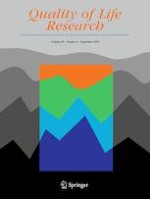22-04-2020
Developmental differences in health-related quality of life in adolescent and young adult cancer survivors
Gepubliceerd in: Quality of Life Research | Uitgave 9/2020
Log in om toegang te krijgenAbstract
Purpose
Adolescents and young adults (AYAs) experience developmental transitions. AYA survivors of cancer are at risk for chronic health conditions due to treatment. This study examined developmental differences in AYA survivors’ health-related quality of life (HRQOL) between age groups and compared to population norms.
Methods
HRQOL was assessed in AYA survivors of cancer (diagnosed before age 30) in long-term follow-up. Cancer survivors who were 12–39 years old at survey completion and completed therapy ≥ 2 years ago were included. HRQOL was assessed using the PedsQL™ and FACT.
Results
Sample size was 155 survivors. PedsQL™ school functioning was worse in 15–17 year olds compared to 12–14 year olds (66.35 vs 77.60, p = 0.012). Compared to population norms, PedsQL™ outcomes were only worse in survivors’ school functioning. Survivors’ 18–39 years old had FACT scores that were better than population norms for overall HRQOL (91.33 vs 80.1, p < 0.001), and in physical (24.22 vs 22.7, p < 0.001), social (23.46 vs 19.1, p < 0.001), and functional well-being (22.94 vs 18.5, p < 0.001). Regression analysis identified that survivors who were < 15 years old and had not relapsed, and survivors who were 15–18 years old and had ≥ 2 late effects are at highest risk of lower HRQOL. For older survivors the highest risk group for lower HRQOL were < 21 years old at survey completion, > 7 years old at diagnosis and > 6 years post therapy.
Conclusion
A trend in school functioning issues in older adolescent survivors emerged. Older survivors show improved HRQOL when compared to the general population. Those further off therapy are at risk of poor HRQOL.
